Politics "Black Baron" in the south of Russia. Battle for Tavria. Part of 2
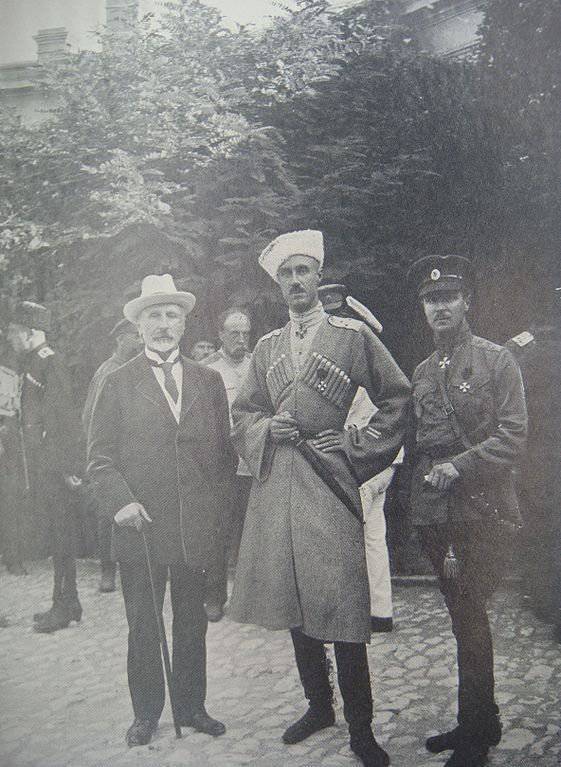
A.V. Krivoshein, P.N. Wrangel, and P.N. Shatilov. Crimea. 1920
Wrangel and Krivoshein actively implemented a series of reforms aimed at improving the economic and social situation of the inhabitants of the Crimean Peninsula and Northern Tavria. Wrangel considered agrarian reform the cornerstone of his program, believing that it was this step that would take the peasants to their side. The government developed and passed the “Land Law”, announced by order of the commander-in-chief of 7 June 1920. It was reported that all land remained in the possession of the owners or owners of them. Any ownership of land, no matter what right it was founded on or in whose hands it was, was subject to the protection of the government. Thus, the peasants secured and legalized the land, which they had already seized during the revolution and civil war. However, those peasants who were allocated land by dividing large estates had to give a certain fee - a fivefold average annual yield for the area. For the payment of this amount was given 25-year installments. After the payment of this amount, the land became the full property of the peasant.
Some lands were returned to the former owners, who before the revolution were allocated to cuts and farms, purchased through the Peasant Bank, experimental farms allocated for experienced cultures, etc. Local government bodies played a major role in the implementation of this reform - zemstvos dominated peasants. This reform was well received by most of the local peasantry. In addition, the government adopted a number of provisions on the regional autonomy of the Cossack lands, and elements of labor legislation were introduced to improve the situation of factory workers.
Wrangel tried to correct the situation in the administrative apparatus. However, the struggle “against the bureaucracy and the routine” quickly died out. To the place of the dismissed officials came others - the same. Instead of overclocked institutions, new ones were created, with similar functions, where the former personnel flowed. To solve the personnel question, an ideology was needed, a certain value system, and not the chaos of the Civil War. In addition, time was needed to restore order in civil administration, but Wrangel did not have it. The commander-in-chief could devote time to civilian government only in the first two, “peaceful” months of his rule. The white command failed to establish information warfare, propaganda, the Reds in this regard were a cut above.
Given how much damage and confusion during the reign of Denikin made the press, which was distinguished by political differences, censorship was introduced. Tolerance for opposition publications is over. True, the Ministry of the Interior gathered such incompetent censors that they managed to edit the speeches of the ministers and even Wrangel himself. As a result, instead of a discrepancy in which it was possible to find reliable information, people began to receive such a minimum of information that did not reflect the real situation on the front.
Wrangell reorganized and counterintelligence. It should be noted that the counter-intelligence activity in the white movement in general was very poorly organized. That in the conditions of a fierce civil war, an atmosphere saturated with espionage, intrigue, the work of underground structures, was one of the prerequisites for the defeat of whites. Firstly, counterintelligence was not a single organization, counterintelligence agencies sought to create not only higher staffs, but also governments, governors, and even parts of civil institutions. Secondly, the White movement in the field of counterintelligence, as in civilian administration, was experiencing a shortage of good personnel. Counterintelligence traditionally enjoyed a bad reputation, so there were mostly not the best officers, but various crooks who, using their position, turned various machinations and people who wanted to sit out in the “rear”, away from the front line. As a result, white counterintelligence was “not terrible and all-powerful”, but weak and often helpless, loose. The personnel in the investigative and investigative work were often incompetent. Counterintelligence became a focus of intrigue, speculation and corruption. Due to professional weakness, red agents also penetrated into the white counterintelligence, gaining in these institutions ample opportunities to carry out their tasks. This weakness was characteristic of all the white armies.
Denikin, in order to strengthen counterintelligence, wanted to attract former employees of the gendarme corps. However, looking back at public opinion was so strong that he did not dare to take this step. In the eyes of the liberal public that prevailed in the White movement, gendarmes were the embodiment of evil. Wrangel went on such a measure. General Klimovich, the former director of the police department, was appointed the head of the special department of the headquarters of the commander in chief and assistant to the head of the civil administration. He recruited his former subordinates. This increased the effectiveness of white counterintelligence. Former gendarmes operated by tried and tested methods, mainly by sending agents provocateurs. Counterintelligence revealed conspiracy on navy, discovered an underground organization in Kerch, defeated the Simferopol city committee and Komsomol, identified organizations in Sevastopol and Feodosia, etc.
In political slogans, Wrangell was cautious. He himself was of right-wing convictions, but with a view to maintaining unity, he considered it important to preserve the principle of the unresolved state system of Russia. The baron said: "We are fighting for the Fatherland, the people will decide for themselves what Russia should be." Wrangel was able to maintain order in the controlled area at a higher level than Denikin. True, we must not forget that under the rule of the “black baron” there was much less territory.
Government of the South of Russia. Crimea, Sevastopol, 1920.
Reorganization of the army and the breakthrough from the Crimea
At the end of April - early May 1920, when Polish troops launched an offensive in Ukraine and occupied Kiev, the command of the Russian army could not conduct active hostilities. There was a process of reorganization of the army. The units experienced an acute shortage of armaments, especially artillery, machine guns, and armored vehicles, which the masses had thrown during the retreat. The main source of replenishment weapons there were Western powers, so I had to wait.
The Red Army in the Crimean sector was practically not weakened, only one cavalry division was removed. The infantry units, after the April battles, were replenished, entrenched in the occupied territory. Now to break from the Crimea was no less difficult than to get to the peninsula.
The White Fleet conducted raids: at the beginning of May Mariupol, Temryuk, Genichesk, Taganrog were fired upon. White ships appeared at the mouth of the Don, at Ochakov, disrupted maritime communications between Odessa, Kherson and Nikolayev, landed small landings, which disturbed the red command.
Much work was done on the reorganization of the army. The structure of Wrangel’s army now included: the 1 Corps (Volunteer) of General Alexander Kutepov, it included the Kornilov, Markov and Drozdov infantry divisions and two cavalry divisions (then a hotel corps was formed from cavalrymen under Barbovich); 2 Corps under the command of Jacob Slaschov - 13-I and 34-I infantry divisions, Terek-Astrakhan brigade; Peter Pisarev's consolidated corps - 1-I and 3-I Kuban divisions, Chechen brigade; The Fyodor Abramov Don Corps - 1-I, 2-I Don Cavalry and 3-I Don Infantry Divisions. 1-I and 2-I Don cavalry divisions - were cavalry only in name, the Cossacks lost their horses during the evacuation. And to provide them with equestrian in the Crimea was not possible. It was believed that during the future offensive, horses would be obtained. Consolidated Corps 7 July 1920 reorganized into a cavalry corps consisting of: 1 and 2 of horse divisions. For the replenishment of the troops, mobilization of 1900-1901 people was conducted. of birth.
By the beginning of June the Kornilov and Drozdov divisions and the Barbovich cavalry were concentrated on Perekop. In the Chongar direction, there is the Markov Division and the Pisarev Corps. Don Corps remained in reserve. Total on the front was about 30 thousand bayonets and sabers.
6 June offensive operation began. 6-thousand troops under the command of Slashchev landed south of Melitopol, in Kirillovka, in order to cut the railway linking the red front with the rear and attack the enemy’s flank. This time the troops managed to transfer secretly. The Red Command was misinformed: rumors were spreading about the landing of an assault force near Odessa, the fleet held a demonstration near the village of Khoroly, west of Perekop. The Red Command hastily transferred troops to the landing site. But they were obviously not enough - about 2 thousand soldiers. Slashchev knocked over the red parts and moved to Melitopol.
June 7 went on the offensive part of the isthmuses. The Perekop defended the Latvian division and the 3-I rifle division, reinforced by international and communist battalions. The 46 Division (Estonian) was stationed at Chongar. It should be noted that the white troops were somewhat ahead of the enemy, the red command itself was going to strike in the near future. The arrival of reinforcements was expected. The fight was very hard. White had to punch through a strong defense, saturated with artillery and occupied by fired, resistant troops. Each step was given heavy losses. For example, the Drozdovskaya division lost half of the commanders in one day of battle. Gradually, Kutepov managed to break through the red defense and advance 10-20 km. But by the evening the red command had brought reserves into battle, and the Red Army pushed the enemy almost to the initial positions.
On the flanks, the situation was slightly better. On the left flank after the breakthrough of the front, the Red troops pressed to the sea. On the right - the troops of Slaschova reached the station Akimovka, where they were stopped by a grouping of the Reds with several armored trains. Fierce battles in former positions continued for several days. Only 9 June has a turning point. Slashchev was able to break the resistance of the Reds from Akimovka and occupied Melitopol by cutting off the Simferopol-Sinelnikovo railway, the main highway through which the 13-I Soviet Army was supplied.
Interestingly, the commander of the 13 Army was Ivan Hristianovich Spider, a former lieutenant colonel of the Russian Imperial Army General Staff. In the future, he will be chief of staff of the Southern Front at Frunze. It is Lieutenant-Colonel General Staff I. X. Spider and Assistant Frunze, former Major General V. A. Olderogge, who will later develop an operation to capture the Crimea.
Slashchev could not connect with the main forces, continuing to act independently. In addition, 10 June Red Army launched a counterattack. The reinforcements arrived - the 15-I Infantry Division and the 2-I Stavropol Cavalry Division. At night, the 2-I cavalry division entered the white rear and struck at Novo-Alekseevka, where the headquarters and some units of the Chechen brigade were located. Whites were partially killed, partially taken prisoner, together with the commander, General Revishin. In the morning, the Red Infantry went on the attack, and the stubborn oncoming battles began again. Wrangel had to throw in reserve - Don Corps. The Cossacks, through requisitions (in fact, outright robbery of the peasants), quickly got horses. This increased their combat capability. The offensive of the Red forces was stopped. The old parts have already suffered heavy losses, and the new ones could not seriously change the situation.
Gradually the red troops, covered from the flanks, began to retreat. For two days, the case of Slashchev was almost surrounded, repelling attacks from three sides. Sweelers resisted all attacks and joined up with the main forces. 22 Junior Field Headquarters Headquarters moved to Melitopol. In the north, the front stopped at the village of Vasylivka, about 45 km from Aleksandrovka (Zaporozhye). The breakthrough operation from the Crimea was completed successfully: the territory of 300 km along the front and 150 km in depth was occupied. The breakthrough to the rich Tavria provided the white troops with food, horse-drawn personnel, increased human reserves. Increased operational capabilities. 13-I army was cut into two parts - on the left bank and right bank (on the Dnieper), lost to 10 thousand people only prisoners and 47 guns.
At the same time, the white units also suffered heavy, hard-to-sustain losses. Corps Kutepova lost a quarter of the composition. The Soviet grouping failed to destroy. 13-I army suffered serious losses, but retained combat capability and retreated, while maintaining the integrity of the front. The operational space of the army Wrangel could not get through. The Soviet command was able to impose a positional battle on White in a confined space where Wrangel's army was doomed. In addition, Polish troops had already rejected from the Dnieper, they were in 200 km from the river and in 500 km from the Wrangel troops.
Soviet offensive against Wrangel in June 1920. Map source: Ya. A. Slaschov Crimea in 1920.
Soviet counteroffensive. Fighting at Melitopol and Kakhovka direction
After the army left the Crimea, Wrangel had to fight almost without interruption. Another offensive was taking place in Tavria, as the red command was already preparing a counterstrike. Given the experience of the victory over Denikin, it was decided to use powerful horse groups to break through. The 1 Cavalry Corps of the Redneck (former cavalcourse Dumenko) was transferred from the North Caucasus. Reorganized and replenished, he represented a serious force - 12 thousand fighters (according to other sources - about 8 thousand), 6 armored cars, artillery. At the same time, the 52 th and 40 th rifle divisions were sent against Wrangel's army, and the re-formed 42 th division was returned from the reserve. They planned to deliver converging blows, cutting off white troops from the Crimean isthmuses, destroying the main forces of the white army in Tavria, not allowing them to retreat to the Crimea. From the west, the Latvian division and the 52 division were to hit. They were supposed to force the Dnieper in the area of Kakhovka and advance on Perekop. The 1 Cavalry Corps of the Redneck was advancing from the east, it was also given the 2 th Stavropol Cavalry Division Dybenko, the 40 Infantry Division with two cavalry brigades, the 42 th division, a squadron of aircraft (9 machines) and armored personnel carriers. This powerful grouping aimed at Melitopol. She had to go to the rear of the white army. It should be noted that the Commander-in-Chief of the Russian Army, Wrangel 25-26 June, from his agents learned about the concentration of the Redneck group and managed to take retaliatory measures.
The defeat of the horse group goons. 28 June Soviet troops launched an operation. A group of commander Dmitry Zhloby in the area of the station Tokmak attacked the 3-th Don division (2-3 thousand people). Chernigov had a rare battle of armored cars, they rammed each other, tried to overthrow the enemy: White lost 4 machines, red ones - 3. The Horse Group of Goons broke through the front of the Don Corps and occupied Chernigov. The Cossacks were defeated, Gundorovsky regiment was cut almost completely. A smaller number of white Cossacks was aggravated by the fact that they were still largely in a hurry, this reduced their combat capabilities and ability to retreat. On the southern flank, the 40-Infantry Division defeated the 2-th Don Division (about 1.5 thousand people) and came to Nogaysk.
On the morning of June 29, the red cavalry left for the Nikolaydorf area, and by 14 p.m. to the Klefeld-Schardau-Marienthal area. Zhloba's group was eager for Melitopol. To stop the enemy, General Wrangel threw the 2nd Cavalry Division (1,5 thousand sabers), the Drozdov Infantry Division (2,5 thousand bayonets) and a detachment against him aviation (20 cars) from the Mikhailovka area. A large role in this battle was played by General Tkachev's aviation detachment. White did not have an advantage in the number of machines, but they were able to concentrate the bulk of their air forces in one area. Cavalry in the steppe was vulnerable: they bombed it, fired machine guns and simply scared away the horses in low-flying flight. The dispersed red parts were easier to throw. The left-flank parts of the Zhloba corps were forced to withdraw to the Gnadenfeld area.
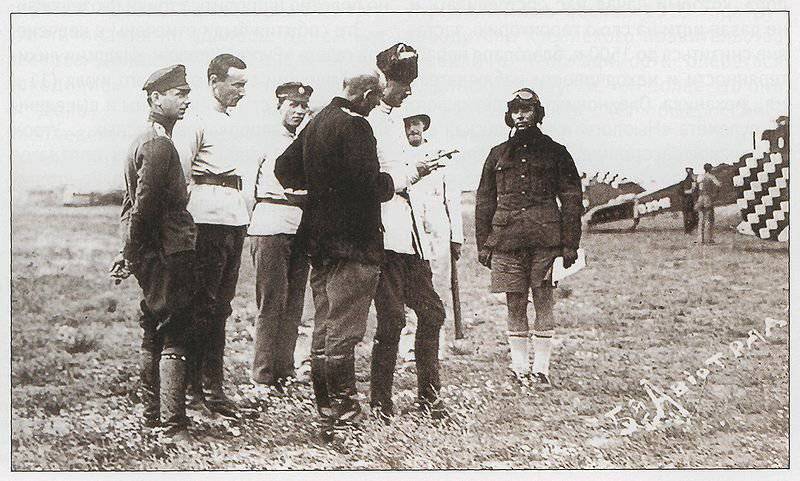
General Baron P. N. Wrangell and the pilots of the Fifth Squadron.
By regrouping the group the Redneck continued the offensive. On July 1, the red cavalry conducted a night raid on the Friedensdorf - Morgenau - Rickenau line. On the night of July 2, the red units carried out a raid on the Blumenort-Tighe-Orlov region, destroying some white infantry. July 2 in the compounds of the 1 Corps Corps and 2 Cavalry Division Dybenko launched an offensive in the general direction Pragenau - Astrakhanka. Fights were already in 15 km from Melitopol.
Wrangel pulled up all free forces, including the Kornilov Division (1,8 thousand bayonets), the Drozdov Division, the 2 Cavalry Division, part of the 13 Division, the remnants of the Don Corps, 4 armored train, aircraft, could take the cavalry group Vloza in the vise section, 3 armored train, aircraft, could take the cavalry group Vloza in the vise section, the armored train 2, aviation, could take the cavalry group in the vise section, and the armies of the Don corps, XNUMX armored train, aviation, could take the cavalry division in the vise squad, the remnants of the Don corps, XNUMX armored train, aircraft. south. July XNUMX white troops launched a counterattack. At first the reds were able to achieve some success. XNUMX-I Stavropol Cavalry Division Dybenko shot down Kornilov, threatening a new breakthrough. But this blow was repelled with the help of aviation. Nevertheless, the Stavropol division maintained a relative order and was able to retreat. The main forces of the Goons, attacked from all sides, mixed. Troop control was lost. The red units did not hold out, and a disorderly retreat began. Some went to the east, others drozdovtsy with armored cars drove to the north, under the fire armored trains, which closed the ring in the area of Tokmak.
As a result, the group of Goons suffered a complete defeat. The 1 Cavalry Corps was dispersed and left in separate groups. Of the white rears went to its only a quarter of the original composition. 1 thousand people were killed, before 9 thousand were captured (according to other sources - more than 11 thousand), whites captured 60 guns, other weapons and property.
The operation to dissect and encircle the army of Wrangel failed. Red troops in the area Kakhovka also acted unsuccessfully. On July 1, they launched an offensive, crossed the Dnieper, and after fierce fighting, occupied Kakhovka. However, they could not break through any further, they were stopped by counterstrokes and forced to go on the defensive.
Wrangel's army was able to temporarily seize the strategic initiative, but was simply unable to develop its success. She was drained of blood and exhausted by the continuous battles. There were no fresh compounds that could be brought into battle and build on success. Even compensate for the loss was more and more difficult. The red command could transfer reserves, make up for losses, replenish bloodless units. With the defeat and the further retreat of the Polish troops, hopes for connection with them melted. It was necessary to break through to the Don, but Wrangel had no strength for that. It was necessary to find a fresh solution.
To be continued ...
- Alexander Samsonov
- Politics "Black Baron" in the south of Russia
Politics "Black Baron" in the south of Russia. Battle for Tavria. Part of 2
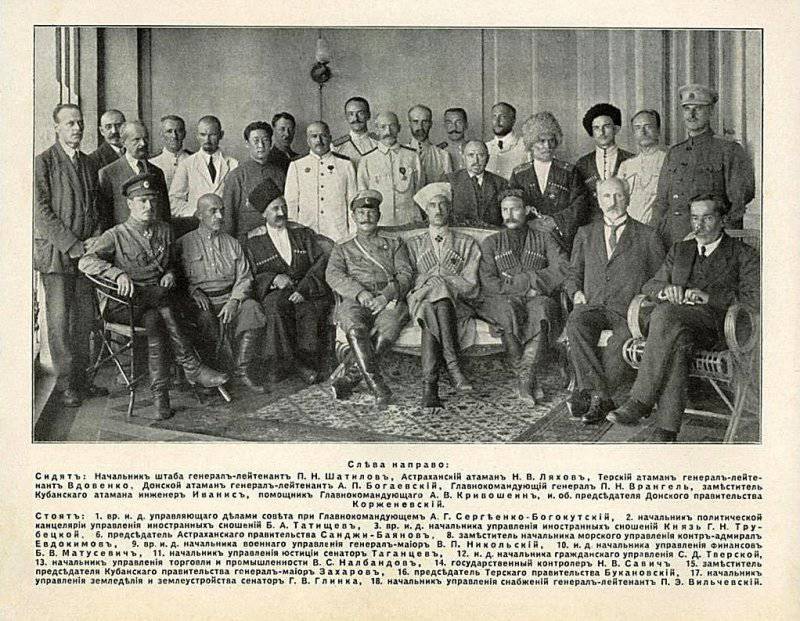
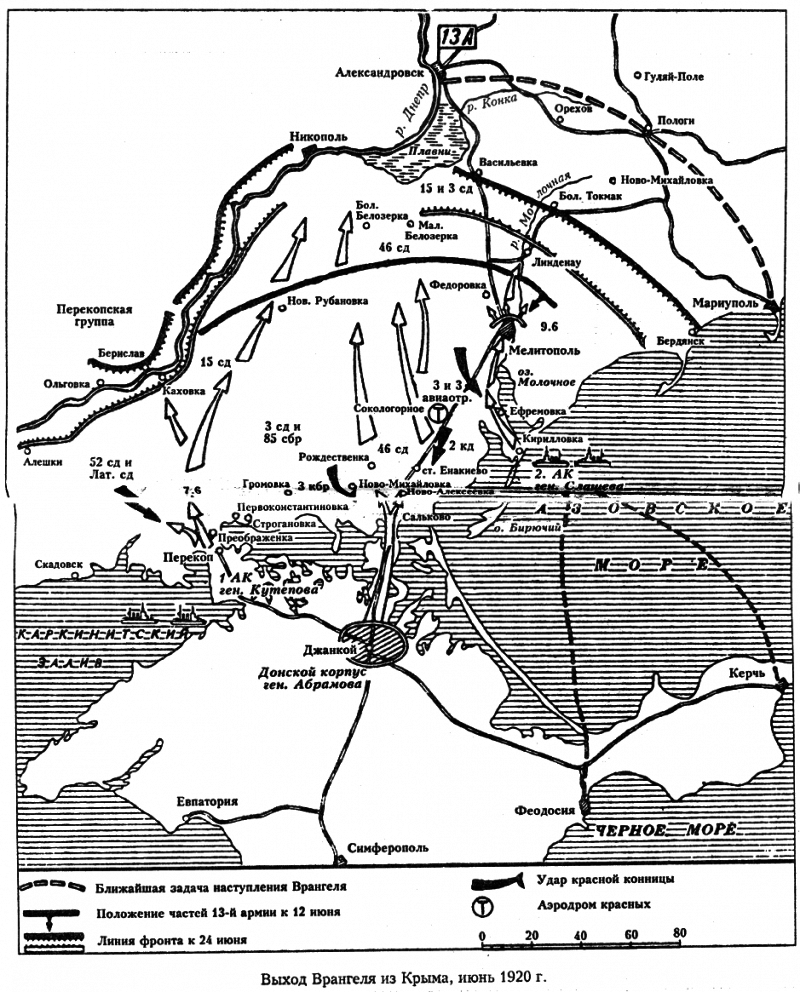
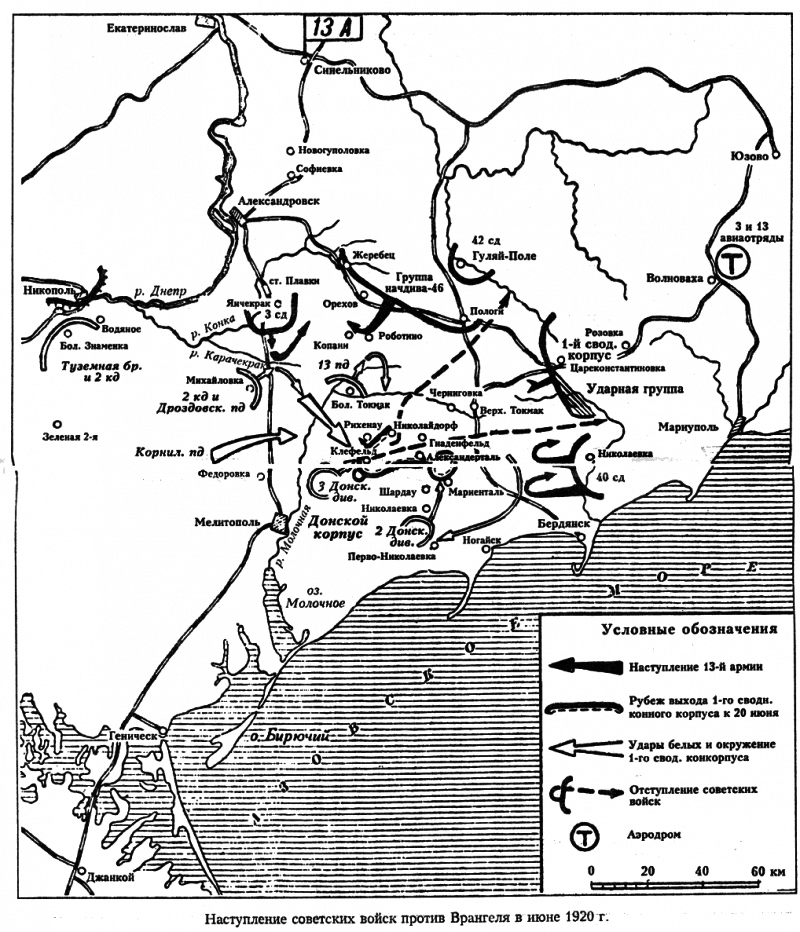
Information